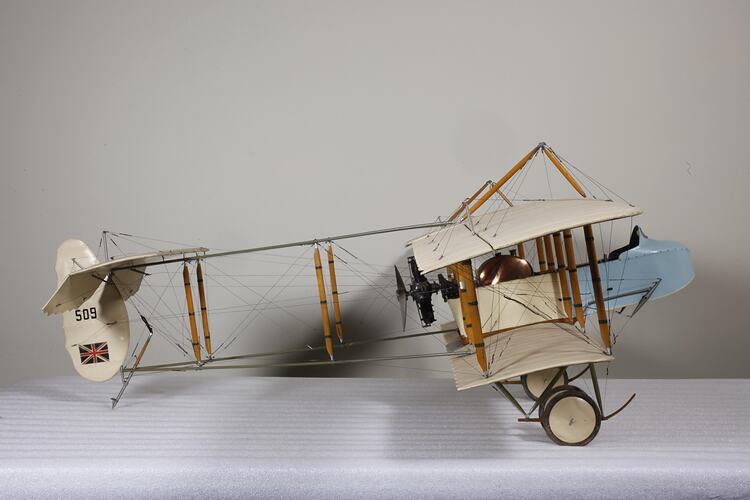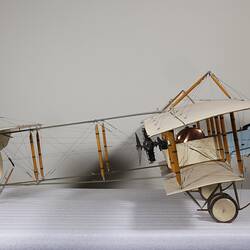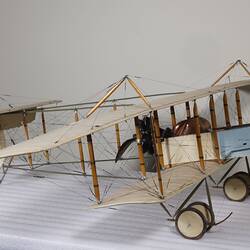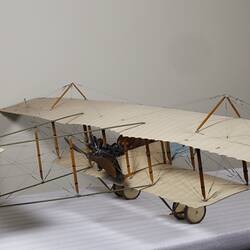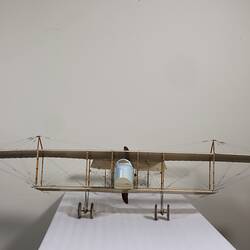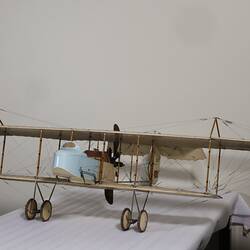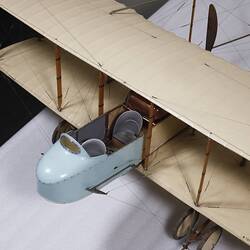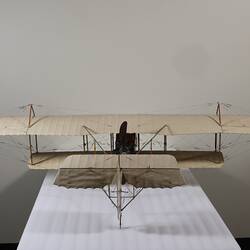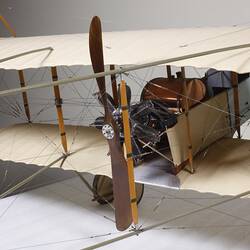Summary
Model History:
Farman F.20 Royal Flying Corps serial no. 509, this 1:8 scale model is the earliest aircraft model acquired by the Museum, purchased for 40 pounds from Mr Charles Desoutter of Baker Street, London in 1915. The Museum's 1917 annual report noted that 'Of the purchased exhibits, probably the model of the Henri Farman biplane, made for the Museum by Mr. Charles Desoutter, of London, has claimed the most attention. It is a complete model on a large scale, and true in every detail.' (page 18)
Charles Desoutter had previously entered a CO2 powered flying model hydroplane in the 1913 London Olympia model flying competition at Hendon. Desoutter invented the first light metal artificial limb which was produced by his firm Desoutter Brothers for thousands of soldiers maimed during World War I. He began experimenting with aluminium prosthetics in about 1914 after his brother Marcel lost a leg in a pre-war flying accident and complained about a heavy wooden leg he received. Charles also pioneered the use of pneumatic drills which were sold by his company which still exists.
World War II Flying ace Douglas Bader was fitted with Desoutter legs.
Aircraft History:
Brothers Henri and Maurice Farman each established their own aviation businesses in France around 1908-09. In 1912, they combined their operations although subsequent models were still often identified as Maurice or Henri Farmans. The Farman factory at Billacourt near Paris produced a range of similar wide-span biplanes which were widely used in training and reconaissance roles. The Central Flying School at Point Cook in Victoria used five examples of the Maurice Farman Shorthorn for pilot training between 1916 and 1919. The Shorthorn name refers to the length of the skids extending in front of the undercarriage which were designed to prevent students from overturning the aircraft on landing. The Farman F.20 was a military reconnaissance and trainer aircraft powered by an 80 horsepower rotary engine. It was used by the French Air Service during the First World War.
Significance
Desoutter invented the first light metal artificial limb which was produced by his firm Desoutter Brothers for thousands of soldiers maimed during World War I. He began experimenting with aluminium prosthetics in about 1914 after his brother Marcel lost a leg in a pre-war flying accident and complained about a heavy wooden leg he received. The design of artificial limbs had attracted much attention in the proceeding years. By the start of the 20th century, the US goverment alone had granted over 150 patents for artificial legs (Ott, 'The Sum of its Parts', cited in Beth Linker, War's Waste, University of Chicago Press, 2011, p.104) - related in part to ageing veterans of the American Civil War.
More Information
-
Collecting Areas
-
Acquisition Information
Purchase
-
Original Source
-
Classification
Air transport, Aircraft, Model propeller biplanes - military
-
Category
-
Discipline
-
Type of item
-
Model Scale
1:8
-
Keywords
Aircraft, Military Aircraft, Model Aeroplanes, Reconnaissance Aircraft, Scale Models, Trainers, Wars & Conflicts, World War I, 1914-1918
